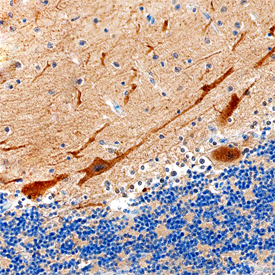Human SACS Antibody Summary
Asn4402-Val4579
Accession # Q9NZJ4
Applications
Please Note: Optimal dilutions should be determined by each laboratory for each application. General Protocols are available in the Technical Information section on our website.
Scientific Data
 View Larger
View Larger
SACS in Human Brain. SACS was detected in immersion fixed paraffin-embedded sections of human brain (cerebellum) using Sheep Anti-Human SACS Antigen Affinity-purified Polyclonal Antibody (Catalog # AF8014) at 3 µg/mL overnight at 4 °C. Before incubation with the primary antibody, tissue was subjected to heat-induced epitope retrieval using Antigen Retrieval Reagent-Basic (Catalog # CTS013). Tissue was stained using the Anti-Sheep HRP-DAB Cell & Tissue Staining Kit (brown; Catalog # CTS019) and counterstained with hematoxylin (blue). Specific staining was localized to Purkinje neurons. View our protocol for Chromogenic IHC Staining of Paraffin-embedded Tissue Sections.
Reconstitution Calculator
Preparation and Storage
- 12 months from date of receipt, -20 to -70 °C as supplied.
- 1 month, 2 to 8 °C under sterile conditions after reconstitution.
- 6 months, -20 to -70 °C under sterile conditions after reconstitution.
Background: SACS
SACS (Spastic Ataxia of Charlevoix-Saguenay; also DNAJC29 and Sacsin) is a 520-540 kDa, novel cytoplasmic chaperone involved neuronal homeostasis. It is expressed in select cell types, including fibroblasts, skeletal muscle cells, cerebellar granule and Purkinje cells, and multiple CNS neuronal phenotypes. SACS is known to play a key role in protein folding, assisting in the adoption of a stable conformation, possibly through the use of ATP hydrolysis. It appears to collaborate with chaperone Hsp70 family proteins, and provide protection against polypeptides containing polyGlu repeats such as ataxin-1. These repeats tend to form annular structures, causing aggregates involving themselves and accompanying molecular partners. Human SACS is 4579 amino acids (aa) in length. It contains a N-terminal ubiquitin-like domain that associates with proteosomes (aa 9-84), three consecutive SRRs/Sacsin Supradomain Regions (aa 90-2900) that possess ATPase activity, a J-domain that intercats with other chaperones (aa 4306-4393), and a HEPN domain (aa 4451-4567) that binds GTP when SACS is dimerized. SACS contains three utilized Ser phosphorylation sites plus one acetylation site at Lys943. There is one alternate start site at Met751, and a 21 aa peptide that can substitute for either aa 730‑750, or aa 812-832. Over aa 4402-4579, human SACS shares 99% aa sequence identity with mouse SACS.
Product Datasheets
FAQs
No product specific FAQs exist for this product, however you may
View all Antibody FAQsReviews for Human SACS Antibody
There are currently no reviews for this product. Be the first to review Human SACS Antibody and earn rewards!
Have you used Human SACS Antibody?
Submit a review and receive an Amazon gift card.
$25/€18/£15/$25CAN/¥75 Yuan/¥2500 Yen for a review with an image
$10/€7/£6/$10 CAD/¥70 Yuan/¥1110 Yen for a review without an image

